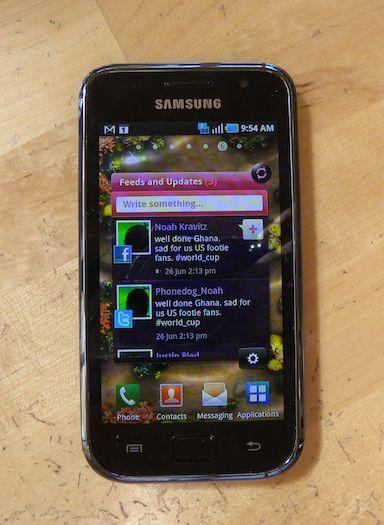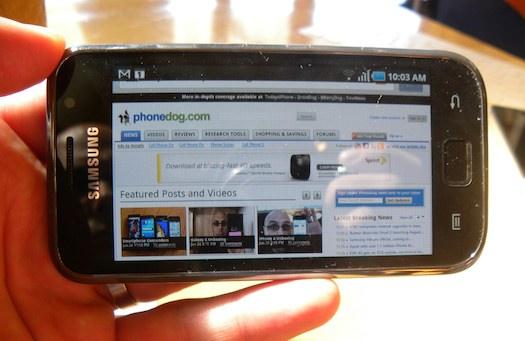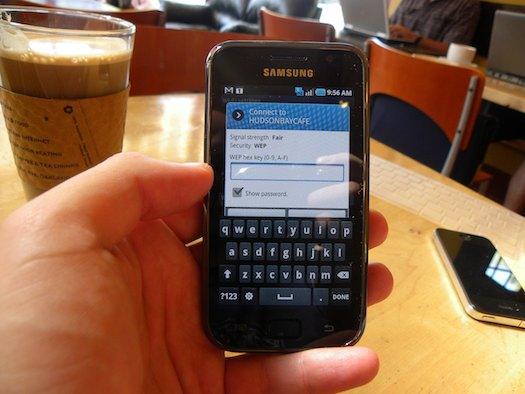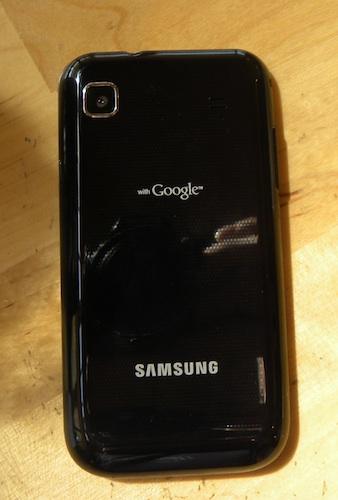
Thanks to the good folks at Samsung Mobile US, I've got myself a week with the unlocked European version of the Galaxy S smartphone (GT-i9000). This is all the more exciting given that I woke up today to the news of Samsung's officially launching Galaxy S variants on five US carriers: AT&T, Sprint, T-Mobile, US Cellular and Verizon. We'll know more about the US versions after tomorrow's big launch event in New York City. For now, here's what I can tell you about the European version on which they'll all be based:
- I'm going to echo what I said when I first saw Galaxy S back at CTIA: 4" may be the sweet spot when it comes to selling "giant screen" smartphones to the average consumer. Galaxy S feels right in my hand where Evo 4G and Droid X feel large, and iPhone 4 feels kinda small after I've been using the S for awhile.
- Galaxy S is incredibly light for a smartphone with a 4" display. Weighing just 118 grams (4.16 oz), S is almost 20% lighter than Apple's iPhone 4, which has a smaller 3.5" screen.
- There are two ways to look at the phone's industrial design and build quality: 1) Samsung created a phone combines a larger than average display and ultra-fast processor with an incredibly light, thin body; 2) The phone is cheap and plasticky feeling. On the one hand, my Galaxy S is super lightweight and has performed very well thus far. On the other hand, when the phone vibrates, it has that hollow buzz to it that I've come to associate with a very low cost, commoditized build quality. Time will tell how the device holds up under daily usage, but it certainly has a different hand feel than phones like the Evo 4G and iPhone 4, which feel luxuriously solid.

- The 4" Super AMOLED display is brilliant and responsive. Super AMOLED performs better than standard AMOLED in bright sunlight (and other harsh lighting conditions), but it's not perfect. Viewing angles are dramatically cut down when using Galaxy S outdoors in the bright sunshine.
- Performance has been quite zippy thus far. Very little in the way of lags and the multitouch display is smooth and quick to pinch, zoom and swipe. I'll have to do some head-to-head tests between the Hummingbird-powered Galaxy S, Snapdragon-powered Evo & Incredible, and Apple A4-powered iPhone 4.

- Samsung's TouchWiz 3.0 UI is an improvement on TouchWiz 2 and 1, mainly because there's less of it. Android with TouchWiz 3 is arguably a little more novice-friendly than stock Android, but Samsung's custom UI will likely turn off some Google fans due to its very iPhone-esque look and feel. Some of Galaxy's custom widgets are just kind of odd in their design, as well - or at least to me. I do like the Daily Briefing app/widget, though - it's just a combined Weather/RSS/Stock/Calendar widget, but it's a nice idea to bring all of those together into one multi-paned window.
- Galaxy S eschews a traditional four-button Android front panel in favor of three buttons placed beneath the display. There's no dedicated search button, which isn't necessarily a big deal, but the giant, bezel-framed home button looks so much like an optical D-pad that I keep trying to navigate through menus with it. From photos I've seen, the US versions of the device will be configured with a more traditional Android button setup.
- From what we hear this morning about the US Galaxy S variants, Sprint's Epic 4G sounds the most interesting: It will feature a slide-out hard QWERTY board and front-facing camera for video chat applications, where the other versions lack both features. Not everyone will want a physical keyboard and the added bulk it brings to the device, but Epic 4G will give Sprint two high-end Android phones (along with Evo 4G) with similar features but different form factors. Smart move on Sprint's part.

I've only got this phone for three or four more days, but I plan to put it through its paces while I do. What do you want to know about Galaxy S in its unlocked European form? Let me know in the comments.



